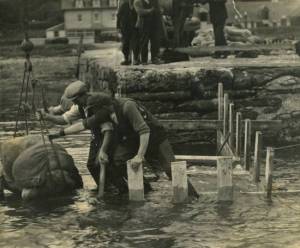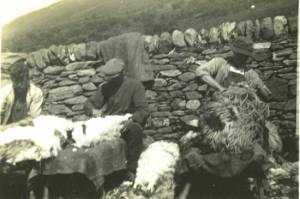Shepherding in 1900
Blackface Sheep Breeders Association founded 1901. In the 16th century, King James IV of Scotland established an improved Blackface flock in Ettrick Forest. During the 17th and 18th centuries. It was known as the Linton Sheep, West Linton in Peeblesshire being the main sale for the type.
In the early 19th century, the breed was taken from Dumfriesshire and Lanarkshire and introduced into the north of Scotland, but due to the high price of cheviot wool the Blackfaces were cleared off the hills in favour of the cheviot. This continued until 1860, when the wool prices reached the same level and the farmers realised that the blackface, with its ability to survive and reproduce in adverse weather conditions, was the best suited breed to utilise hill and mountain grazing.
In the late 19th century, there was an upsurge in interest in breed improvement. Many of the farms that sold high priced tups and enthusiastically promoted the breed at that time possessed names that are still well known today.
1905 the last of the sheep were being taken of the hills in favour of deer on most of Ardkinglas Estate.
Average wool price
Average lamb price
Average cast ewe price
The average wage for a shepherd was.....
In the early 19th century, the breed was taken from Dumfriesshire and Lanarkshire and introduced into the north of Scotland, but due to the high price of cheviot wool the Blackfaces were cleared off the hills in favour of the cheviot. This continued until 1860, when the wool prices reached the same level and the farmers realised that the blackface, with its ability to survive and reproduce in adverse weather conditions, was the best suited breed to utilise hill and mountain grazing.
In the late 19th century, there was an upsurge in interest in breed improvement. Many of the farms that sold high priced tups and enthusiastically promoted the breed at that time possessed names that are still well known today.
1905 the last of the sheep were being taken of the hills in favour of deer on most of Ardkinglas Estate.
Average wool price
Average lamb price
Average cast ewe price
The average wage for a shepherd was.....


